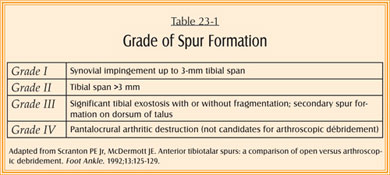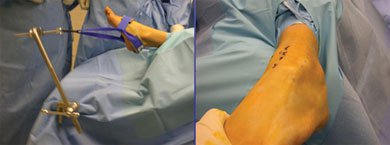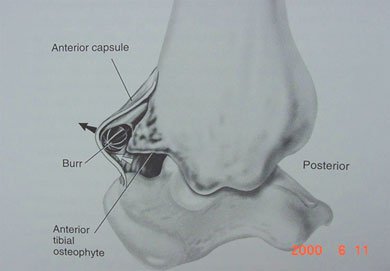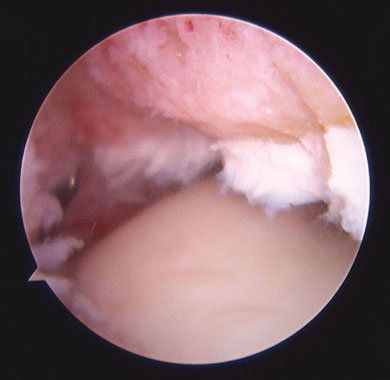Will an Ankle Arthroscopy and Removal of Bone Spurs Help Me?
The advent of ankle arthroscopy has eliminated the need for open arthrotomy for a number of disorders ranging from loose bodies, soft tissue impingement, osteochondral lesions, and even some arthrodesis. The critical question in regard to the patient described above is to determine if the lesion is simple impingement or osteoarthritis. Impingement spurs are common from repetitive microtrauma from forced dorsiflexion or capsular avulsion from plantarflexion. The chief complaint is difficulty with dorsiflexion range of motion—squatting, pushing off, running, or going up or down stairs. Symptoms are of a gradual onset and usually do not prevent the patient from attempting to perform activities. Complaints are not typically of pain but of a mechanical obstruction or block. Classically, the physical exam will show decreased ankle range of motion, particularly in dorsiflexion compared to the opposite limb. This may further be accentuated by having the patient attempt to squat and noting how the affected heel will rise off the ground earlier than the opposite side. Pain may be elicited with palpation anteriorly over the joint line and the examination may be able to palpate the osteophyte. Limited dorsiflexion may also be due to gastrocnemius contracture, which can be assessed during the exam. Patients will describe tightness in their Achilles versus an anterior joint line mechanical obstruction while attempting maximal dorsiflexion (see Question 12).
Diagnostic assessment should include weight-bearing anteroposterior and lateral radiographs. On the lateral view, the angle between the distal tip of the tibia and talus should be greater than 60 degrees. A computed tomography or magnetic resonance imaging scan can be an adjunct in helping to determine if there is adequate cartilage remaining to afford débridement. Impingement spurs are usually anterolateral but can be anteromedial or central. While the spurs are more common at the distal anterior aspect of the tibia, there can be a corresponding “kissing” lesion on the talar neck. Scranton and McDermott have classified these from Grades I through IV. Grade IV lesions were not as amenable to arthroscopic resection (Table 23-1). However, if radiographs show a well-maintained joint space combined with a physical exam of isolated anterior tenderness, then there may be a role for arthroscopic débridement (Figure 23-1). This patient population will do well with ankle arthroscopy and removal of anterior osteophyte provided they do not have more global arthritic changes. The preoperative discussion needs to be thorough and include expectations about the surgery. Although activity-related pain will usually decrease, the range of motion may not change significantly.1


Figure 23-1. (A) Anterior osteophyte with tibiotalar angle more than 60 degrees. (B) Postresection.
The second population is those spurs seen due to osteoarthritis. In cases of osteoarthritis, patients will have more typical arthritic symptoms such as morning and start-up pain and stiffness, weather-related changes, and more chronic pain in all weight-bearing phases of the gait cycle. Symptoms are usually gradual in onset and are commonly associated with a previous history of trauma. Weight-bearing radiographs in this patient population will typically show more global and diffuse joint space narrowing. While these patients may show evidence of significant anterior osteophytes, their radiographs are typically more globally involved. These patients, similar to patients with knee osteoarthritis, do not do well with a simple ankle arthroscopy and débridement. Unless symptoms are focalized or there is discrete evidence of loose bodies, arthroscopy should not be attempted.
Ankle Arthroscopy
If nonoperative measures such as heel lifts, nonsteroidal anti-inflammatory drugs, gastrocnemius soleus stretches, and intra-articular steroid injections have failed, then resection may be indicated. Noninvasive distraction and inflow are needed. Standard anteromedial and anterolateral portals should suffice (Figure 23-2). Visualization of the anterior and inferior extent of the spurs needs to be exposed using a 3.5- or 4-mm aggressive oscillating shaver to remove the anterior capsule off the distal tibia. The bone may be burred (4 mm) by shaving in a single direction (Figures 23-3 through 23-5). I often find that an aggressive resection is required. Intra-arthroscopy assessment of the resection is typically less than what the radiographs will show. A lateral radiograph ensures complete resection at the end of the procedure. My goal intraoperatively is 5 degrees of dorsiflexion motion. Intra-articular assessment with the ankle in maximal dorsiflexion with direct visualization is performed; further anterior bony resection is performed versus consideration for a posterior procedure. After adequate anterior decompression has been confirmed and ankle dorsiflexion is still not 5 degrees past neutral, then a Strayer gastrocnemius recession should be considered.

Figure 23-2. Arthroscopy setup.

Figure 23-3. Anterior osteophyte right ankle with burr.

Figure 23-4. Right ankle using 3.5-mm aggressive shaver to débride the anterolateral tibial impingement spur.

Figure 23-5. Anterior distal tibia after osteophyte removal.
Postoperative Protocol
Portal sites are sutured, a sterile dressing applied, and a 3-sided plaster splint is applied. Nonweight bearing of the affected limb is ordered. The dressing and sutures are removed at 7 to 10 days postoperatively. Progressive weight bearing is commenced. If a Strayer recession was performed, a Controlled Ankle Motion walker is used for an additional
2 weeks. Eccentric calf strengthening and gastrocsoleus stretches are emphasized. Return to sports can be at 6 to 10 weeks postoperatively. This is usually delayed an additional
4 to 6 weeks if a Strayer procedure was performed.
Reference
1. Ferkel RD, Cheng JC. Ankle and subtalar arthroscopy. In: Kelikian A, ed. Operative Treatment of the Foot and Ankle. Stamford, CT: Appleton & Lange; 1999:321-350.
